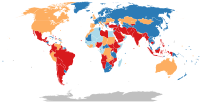
Photo from wikipedia
Background Nationwide restrictions started in Finland in March to prevent the spread of COVID-19, leading to school and day care closures. The aim of this study is to describe the… Click to show full abstract
Background Nationwide restrictions started in Finland in March to prevent the spread of COVID-19, leading to school and day care closures. The aim of this study is to describe the effect of closures and re-openings on the respiratory pathogen epidemiology. Methods Laboratory-confirmed cases of SARS-CoV-2; respiratory syncytial virus (RSV); influenza (A & B); parainfluenza-, adeno-, and rhinoviruses; Mycoplasma pneumoniae; and Streptococcus pneumoniae in children were collected from the National Infectious Disease Register over the period of 2017–2020. Weekly incidences (weeks 1 to 35) with 95% confidence intervals (CIs) were calculated per 100 000 children in 2020 and compared by incidence rate ratios (IRRs) to corresponding periods in 2017−2019. Findings The lockdown had immediate impact on the incidences of respiratory pathogens except SARS-CoV-2. Week after the lockdown began IRR was 0•3 (CI 0•3–0•4) and next week the IRR was 0•1 (0•1–0•2). The incidence of SARS-CoV-2 started to decline eight weeks after the lockdown began. The highest recorded weekly incidence of SARS-CoV-2 was 7•2/100 000 children. The effect of the lockdown lasted until late summer. Rhinovirus and SARS-CoV-2 began to increase before the schools or day cares opened in August. The re-opening of schools seemed to have no impact on the incidence of any pathogen. Interpretation Our results suggest that general social distancing, including school and day care closures, played a crucial role in reducing infections, and the effect lasted for several weeks. The re-opening of schools and day care centres seems to have had no immediate impact on the incidences of any respiratory pathogens. Funding This study had no funding source.
Journal Title: EClinicalMedicine
Year Published: 2021
Link to full text (if available)
Share on Social Media: Sign Up to like & get
recommendations!